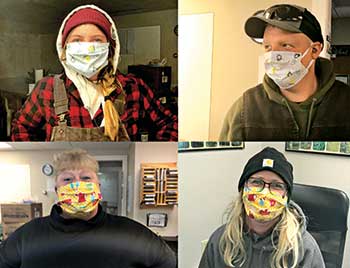
For Graham Pellettieri, technology director and project manager at Pellettieri Associates, a landscape design/build firm in Warner, N.H., the coronavirus pandemic has thrown a curveball into the design process.
“Having people working from home and not physically together added a challenge of the physical distance and separation,” he says. “Conversations you may’ve had with an employee stopping by their desk, you have to pick up the phone, email or do a Zoom call. There’s a little more legwork involved in just staying fully engaged and connected and being able to have those progressive conversations with fellow employees and coworkers.”
Pellettieri sheds light on how his company has kept up its operations during the coronavirus pandemic, while ensuring that its clients and employees remain safe.
Another option
Since the start of the pandemic, Pellettieri Associates has opened up new opportunities to connect with clients virtually. In most cases, it’s a Zoom meeting between a client and a project manager or designer.
“The virtual option is a great option to have on the table,” Pellettieri says. “There’s a lower risk of safety concerns that comes with the virtual environment.”
While the company employed the virtual option before the pandemic, it has since ramped up virtual meetings, with about 30 percent of its meetings with clients being conducted virtually. Before the pandemic, less than 10 percent of meetings were conducted virtually.
He notes that the company still does a fair number of on-site meetings.
“It’s all about taking precautions and measures we’ve put in place, and sometimes it’s taking separate vehicles to job sites for meetings with clients,” he says. “There’s something invaluable about being on that property with the client and able to walk alongside them and make comments or changes. We’re fortunate that we’re outdoors, which allows us to have more flexibility in meeting clients while keeping everyone safe.”
When the company conducts virtual meetings, typically through Zoom, a designer or project manager presents items, such as the conceptual designs, drawings, 3D renderings and plant selections, to the clients.
“We’re able to share our screen with clients and walk them through virtually in the design to connect them to the project and the different concepts,” Pellettieri says. “It’s really helpful to us to be able to be on the same page visually. As far as dialogue, there’s also the opportunity for the client to ask questions and chime in with additional details or requests.”
The company has also moved many of its files to the cloud-based data storage app Dropbox.
“That was a benefit because you could access the files from home (for people working remotely), from the office or from a job site,” Pellettieri says. “Right away, there was ink-free accessibility to all of our employees. It also opened up the ability for us to easily share content with people.”
Looking ahead
Pellettieri says that even once the pandemic subsides, he expects to maintain the virtual option during the design process, especially for job sites that may be far away or hard to access or for clients who may have scheduling issues.
“Being more mobile with technology, using software and communicating design concepts with clients in a virtual environment is going to stick,” he says. “You can work on those projects at any time of day (and) connect with people in different ways. I think that’s opened up some doors that we didn’t have prior to the pandemic.”
He adds that he’s also hopeful for the future of design work because he’s noticed many people have taken a renewed interest in their outdoor spaces.
“People are spending more time at home, and they’re looking into their backyard,” he says. “You couple that with the fact that people aren’t vacationing or traveling like they used to, and some of those funds are used for projects.”


